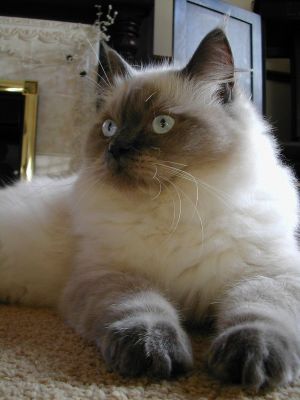
Ragdoll and Ragamuffin
Veterinarian Reviewed on January 4, 2008 by Dr. Janice Huntingford
Physical Characteristics
Breed Group:
The Ragdoll is a member of the Longhair Group. Category I, Established (TICA Standards).
Weight:
10-20 lbs. (4.5-9 kg.)
Height:
Male: large, muscular build; female slightly smaller.
Color(s):
Pointed cats are born white and develop their color and patterns later. Colors can include seal, chocolate, blue and lilac, red and cream. Tortie and tabby patterns.
Coat:
The Ragdoll sports a coat that is short or medium long. The dense and silky hair flows on the body. In summer, the coat may be shorter.
Overview
Character:
The intelligent Ragdoll is devoted and loyal to its owner. When relaxed, this cat gives an impression of a floppy ragdoll.
Country of Origin:
U.S.A.
History:
In the 1960s a white longhair and a Birman or Birman-like tom owned by Ann Baker produced loving kittens with a gentle disposition. Although other Associations did not accept these original Ragdolls, later major registries accepted their descendants.
Name:
These relaxed cats went limp like a ragdoll, as observed by Ms. Baker.
Temperament:
The gentle Ragdoll is quite playful. A genial cat, it loves human company and interaction. This affectionate breed gives a relaxed impression. The Ragdoll does not fight.
Care:
Training:
Introduce good grooming when young. They will like the attention given. Training your cat with rewards will help.
Activity:
The Ragdoll is not an active cat. A scratching post or other scratching surface will encourage this natural behaviour. This sociable cat enjoys participating with humans.
Ownership:
Owners need to be aware the Ragdoll should be kept indoors. This breed cannot defend itself from other animals. With its docile nature, this cat likes to be held. The Ragdoll has a quiet voice. This cat seems to tolerate a variety of situations. Take care that this low activity cat should not become obese. The coat needs daily combing.
Breeders:
No breeders listed at this time.
Sign up for our newsletter and receive more articles and the latest pet health updates and special offers.
Our Expert
 Dr. Janice Huntingford
Dr. Janice HuntingfordJanice Huntingford, DVM, has been in veterinary practice for over 30 years and has founded two veterinary clinics since receiving her Doctor of Veterinary Medicine at the Ontario Veterinary College, University of Guelph. She has studied extensively in both conventional and holistic modalities. Ask Dr. Jan

